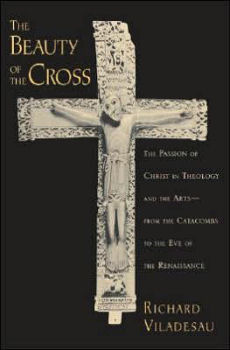
|
Posted January 30, 2006
Book: The Beauty of the Cross: The Passion of Christ in Theology and the Arts — From the Catacombs to the Eve of the Renaissance Author: Richard Viladesau Oxford University Press, New York, 2006, pp. 214 An Excerpt from the Jacket:
In this volume Richard Viladesau seeks to understand the beauty of the cross as it developed in both theology and art from the beginnings until the eve of the Renaissance. He argues that art, and symbolism functioned as an alternative strand of theological expression — sometimes parallel to, sometimes interwoven with, and sometimes in tension with formal theological reflection on the meaning of the crucifixion and its role in salvation history. Using specific works of art to epitomize particular artistic and theological paradigms, Viladesau then explores the contours of each paradigm through the works of representative theologians as well as liturgical, poetic, artistic, and musical sources. The beauty of the cross is examined from Patristic theology and the earliest representations of the Logos on the cross, to the monastic theology of victory and the Romanesque crucified “majesty,” to the Anselmian “revolution” that centered theological and artistic attention on the suffering humanity of Jesus, and finally to the breakdown of the high scholastic theology of he redemption in empirically concentrated nominalism and beginnings of naturalism in art. By examining the relationship between aesthetic and conceptual theology, Viladesau deepens our understanding of the foremost symbol of Christianity. An Excerpt from the Book: Athanasius gives several further reasons for the suitability of the cross as the instrument of Christ’s death. He argues that in order to bear the curse laid upon us, Christ had to receive the death set for a curse, that is, the cross: for “cursed is he how hangs on a tree.” Moreover, the spreading out of his arms on the cross symbolizes Christ’s gathering all peoples, Gentiles and Jews, to himself: “When I am lifted up, I shall draw all people to myself.” Since the lower atmosphere was the place where the devil wandered since his expulsion form Heaven, it was suitable for him to be defeated in his own territory, through Christ’s being lifted into the air on the cross. Furthermore, unlike other forms of execution, like beheading, crucifixion left the body of Christ undivided, as was suitable to the symbol of the unity of the church. Athanasius mentions that the Word suffers through its union with humanity. But despite the affirmation of the necessity of Christ’ death as a sacrifice and ransom, notably absent from Athanasius’s treatment of redemption is any stress on the suffering itself. On the other hand, Athanasius stresses the humility of the Word in undertaking such a union and in undergoing a disgraceful form of death. Table of Contents: 1. The beauty and the scandal of the cross 2. The cross in the New Testament and the Patristic paradigm 3. The monastic paradigm and the romanesque style 4. The theology of high scholasticism and Gothic Art 5. Nominalism, naturalism, and the intensification of passion piety |
|
